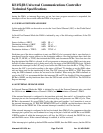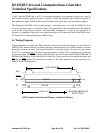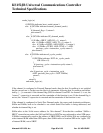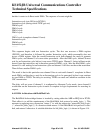
KS152JB Universal Communications Controller
Technical Specifications
Kawasaki LSI USA, Inc. Page 85 of 120 Ver. 0.9 KS152JB2
When the arbiter wants to DMA the XRAM, it first activates DMXRQ. This signal prevents Q2
from being set if it is not already set.An output low from Q2 enables the arbiter to carry out its
DMA to XRAM, and maintains an output high at
HLDA. When the arbiter completes its DMA,
the signal DMXRQ goes to O, which enables Q2 to accept signals from the
HLD input again.
4.3.5 Internal Logic of the Requester
The internal logic of the requester is shown below. Initially, the requester’s internal signal
DMXRQ (DMA to XRAM Request) is at 0, so Q2 is set and the
HLD output is high. As long as
Q2 to be cleared (but doesn’t clear it), and, if
HLDA is high, also activates the HLD output.
A 1-to-0 transition from HLDA can now clear Q2, which will enable the requester to commence
its DMA to XRAM. Q2 being low also maintains an output low at
HLD. When the DMA is com-
pleted, DMXRQ goes to 0, which sets Q2 and de-activates
HLD.
Only DMXRQ going to 0 can set Q2. That means once Q2 gets cleared, enabling the requester’s
DMA to proceed, the arbiter has no way to stop the requester’s DMA in progress. At this point,
de-activating
HLDA will have no effect on the requester’s use of the bus. Only the requester itself
can stop the DMA in progress, and when it does, it de-activates both DMXRQ and
HLD.
HLD Input
CPU Osc.
Periods
Clock 1
Clock 2
HLDA Output
2 Osc.
Periods
4 Osc.
Periods
HLDA
Clock 1
DQ
Q1
DMXRQ
Clock 2
Clock 1
D
Q
Q3
HLD
S
Q
Q2
R
Q
Inhibit Requester’s DMA to XRAM
HLD
(Q3)
D
Q
Q1A
Clock 2


















